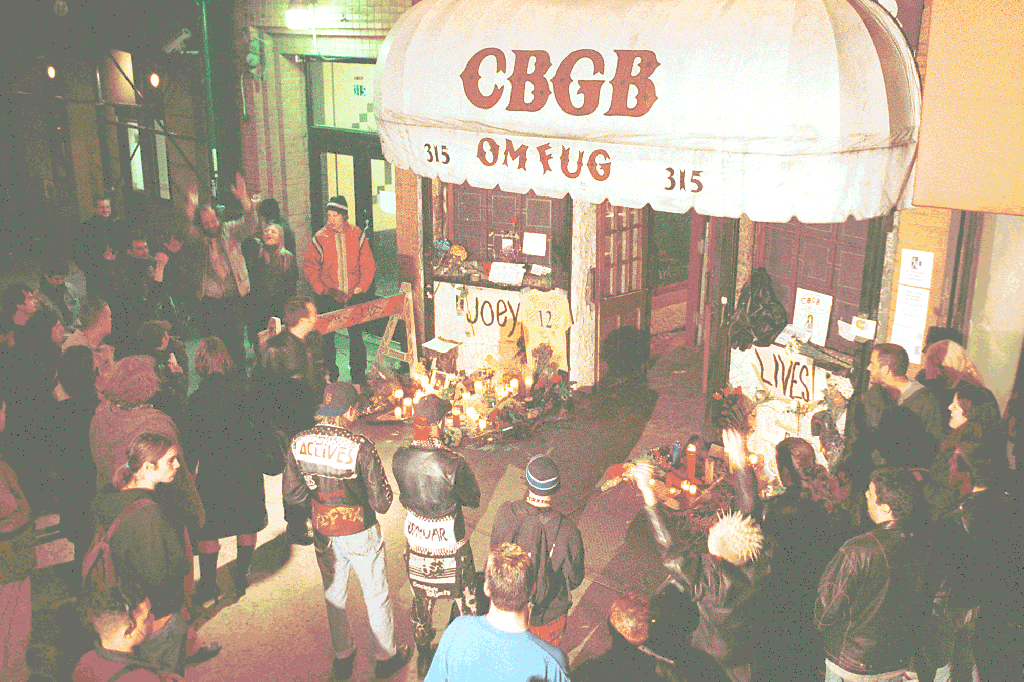In the mid- to late ’70s, the B-Girls were just one of the many bands that found their punk people at CBGB — the iconic New York rock club that started a music movement five decades ago.
In fact, the all-female act made themselves so at home at the East Village institution that they once played in their pajamas at a benefit gig — with a loaded lineup including Patti Smith, Elvis Costello and CBGB house band Mink DeVille — after club owner Hilly Kristal kept pushing their set time back.
“We used to use the Ramones’ loft around the corner [at 6 East 2nd St., now known as Joey Ramone Place] as our dressing room because it was horrible at CBGB,” Ross told The Post.
“So we went over to the Ramones loft, and we changed into our pajamas. And we wore these pink flannel pajamas and cowboy boots back over to CBGB’s, and we brought pillows. We went on right after Allen Ginsberg — you know, the serious beat poet — and then we’re up there in pajamas singing ‘Fun at the Beach.’ ”
And the B-Girls would make connections with other legendary CBGB bands such as Blondie, who broke the scene out of the club underground and to the top of the pop charts with “Heart of Glass” in 1979.
And from Television to Talking Heads, the club that the late Kristal opened on Dec. 10, 1973 became something totally different than what he originally envisioned with those initials standing for Country, Bluegrass, Blues.
“It started out with, you know, a few drunks and a few friends,” Blondie frontwoman Debbie Harry told The Post. “It was just, like, the local bar [with] some bikers, some Bowery guys.
“And then it became the place to go. It gave everyone sort of a sense of community, a sense of purpose.”
Photographer Bob Gruen — who shot everyone from the Ramones to Patti Smith on the club’s closing night on Oct 15, 2006 — said that, in its boom years, CBGB captured the carefree spirit of the local scene, fostering creativity without commercial expectation.
“It was a very free, open kind of place,” he said. “The bands were having fun. I think the biggest goal was that maybe you’d meet a girl and then maybe you’d get a free drink. But nobody was expecting world domination.”
Indeed, CBGB was born out of low-rent rebellion as New York City was on the verge of going bankrupt.
“It was pretty much a dump,” said photographer Roberta Bayley, who went from working the door to shooting the cover of the Ramones’ 1976 self-titled debut album and becoming chief shutterbug of Punk magazine. “It was just a drinking bar — you know, for professional drinkers that just drink.
“It wasn’t a happening club,” she continued. “The band asked Hilly if they could play there, and he said, ‘Sure.’ That was his greatest skill: He said, ‘Yes.’ And he kind of saw some spark of originality and determination in those early people.”
One of those early bands was Television, which had a residency at CBGB’s in the mid-’70s. And Bayley’s romance with guitarist Richard Lloyd led to her doorwoman duties in 1974.
“Their manager asked me if I would take the money at the door,” she said. “It was at a time when there were maybe 20 people in the crowd. So if somebody came in we didn’t know, we wanted to charge them.
“But you didn’t have to be rich. If you had $2, you could go there.”
Gruen first went to CBGB to see Television — with the Stilettos, featuring a pre-Blondie Harry and Chris Stein, opening for them — in 1974 .
“David Johansen [of the New York Dolls] mentioned to me that there was a bar opening on the Bowery, and so we went down there,” said Gruen. “And we started taking pictures of the bands at CBGB because we liked them — not because they had a record contract. In fact, most of them didn’t have a record contract.”
Gruen could see, feel and smell the true grit that well earned CBGB’s grungy rep symbolized by its famously filthy bathroom.
“Hilly had a couple of dogs that he left in there at night to kind of keep the place safe,” he said. “But nobody walked the dogs. So you had to be careful when you walked around the club because you might step into something.”
But out of the depths of dinginess arose something special.
“It was just so original and authentic, and had nothing to do with the music business,” said Ross. “We were rebelling against what was being played on the radio. And, you know, things in the city were falling apart at that time. And when there’s cracks in the system, that’s when creativity happens. It’s an opening for new creativity.”
And 50 years later, even as the location at 315 Bowery is now a John Varvatos store, the CBGB legacy lives on: Jonathan Wells’ new novel, “The Sterns Are Listening,” is set against the club’s ’70s backdrop, while in 2024 the CBGB estate — which continues to roll in the dough on those trademark t-shirts — is looking for a new Lower East Side space to carry on its tradition.
“Some kind of mythological energy still exists,” said Harry. “We were lucky we were there.”
Source link









